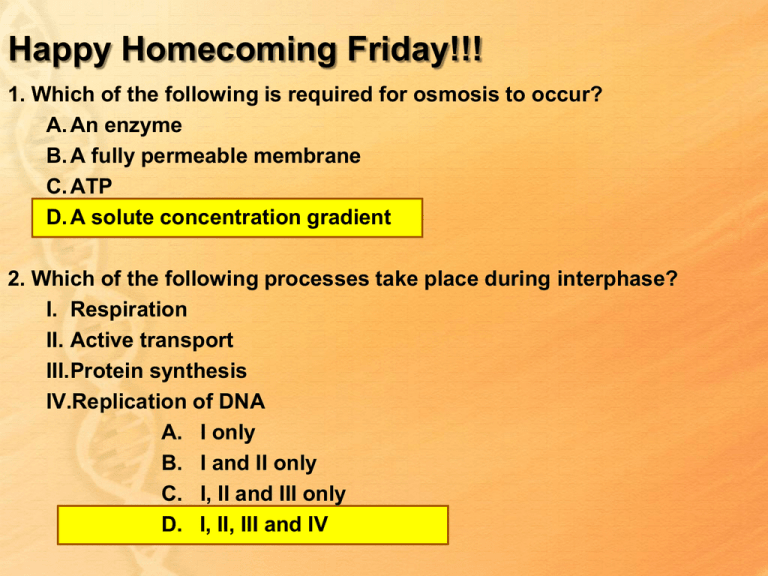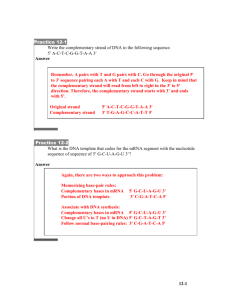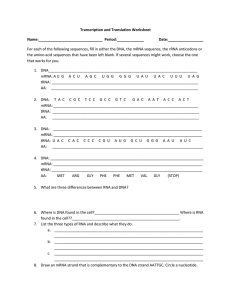IB Topics: DNA, Transcription, Translation
advertisement

Happy Homecoming Friday!!! 1. Which of the following is required for osmosis to occur? A. An enzyme B. A fully permeable membrane C. ATP D. A solute concentration gradient 2. Which of the following processes take place during interphase? I. Respiration II. Active transport III.Protein synthesis IV.Replication of DNA A. I only B. I and II only C. I, II and III only D. I, II, III and IV Pelican Book 1st • Then IB book 3.3 • THEN go over diffusion/osmosis lab • Test Corrections due when?!?! IB Topics: DNA, Transcription, Translation 3.3, 3.4, 3.5 http://simplescience.net/dna.html 3.3 DNA Structure 3.3.1 Outline DNA nucleotide structure in terms of sugar (deoxyribose), base and phosphate. • Chemical formulas not required! • Simple shapes! • Bases: – – – – A T G C • Carbon #s 3.3.2 State the names of the four bases in DNA. PYRIMIDINES 3.3.3 Outline how DNA nucleotides are linked together by covalent bonds into a single strand. • Phosphodiester bond = cov • 5’ P group + 3’ OH group • Condensation rxn—water Released Nucleotides added to 3’ end! Sugar-phosphate backbone 3.3.4 Explain how a DNA double helix is formed using complementary base pairing and hydrogen bonds. • A-T; G-C – A, G are purines—bigger – T, C are pyrimidines—smaller • Consistent width of dbl helix • Opposite directions (anti-parallel) 3.3.5 Draw and label a simple diagram of the molecular structure of DNA TOK: story of elucidation of DNA structure (collaboration; Watson and Crick’s discovery of 3D structure dependent on Franklin’s data…shared without her knowledge or consent!!!) 3.4 DNA Replication 3.4.1 Explain DNA replication in terms of unwinding the double helix and separation of the strands by helicase, followed by formation of the new complementary strands by DNA polymerase. • Interphase, before cell division – Chromatin • Helicase (100s of base pairs per sec!) – Moves base pair at a time, breaks H bonds – Each strand is now a template • DNA polymerases – Covalent bonds b/w new strand n’tides – Free nucleotides (nucleoside triphosphates) 3.4.2 Explain the significance of complementary base pairing in the conservation of the base sequence of DNA. • Double stranded, complementary • Each becomes a template • Complementary Identical daughter strands • Accuracy for passing on information – Gene expression – Fatal mistakes 3.4.3 State that DNA replication is semiconservative. • Neither is completely “new” – (Semi-conservative) • Meselson & Stahl expts • Heavy & light isotopes of N 3.5 Transcription & Translation 3.5.1 Compare the structure of RNA and DNA. **similarities & differences!! 5 are listed (not 10!): DNA RNA 5-C sugar 5-C sugar Deoxyribose sugar Ribose sugar Each nucleotide has 1 of 4 nitrogenous bases Bases are C, G, A, T Each nucleotide has 1 of 4 nitrogenous bases Bases are C, G, A, U Double-stranded Single-stranded Why’s the nucleus called the “control center”? • Protein synthesis • Some are enzymes • Effects biochemistry of cell...carbs, lipids, etc. 3.5.2 Outline DNA transcription in terms of the formation of an RNA strand complementary to the DNA strand by RNA polymerase. • Gene region on DNA is unzipped • RNA polymerase moves along template DNA strand (1) & complementary RNA n’tides pair • U instead of T • Compl copy of ONE GENE of the chromosome 3.5.3 Describe the genetic code in terms of codons composed of triplets of bases. • • • • 3 mRNA bases Codes for ONE amino acid “codon” Sequence for polypeptide Happy THURSDAY!!! March 4th! Test Monday, Articles & Review Tomorrow! 1. During the process of translation which of the following statements describes the relationship between nucleic acids? A. Anticodons on mRNA bind to complementary codons on DNA. B. Anticodons on tRNA bind to complementary codons on mRNA. C. Bases on DNA bind to complementary bases on mRNA. D. A single strand of mRNA is produced from the DNA in the nucleus. 2. Define the term degenerate as it relates to the genetic code. (1 mark) more than one codon / base triplet codes for an amino acid 1 Translation 3.5.4 Explain the process of translation, leading to polypeptide formation. • Include the roles of messenger RNA (mRNA), transfer RNA (tRNA), codons, anticodons, ribosomes and amino acids. RNA • mRNA: – complementary copy of a gene, codes for one polypeptide • rRNA: – ribosomal (ribosome = rRNA + ribosomal protein) • tRNA: – transfers ONE of the 20 AA to ribosome for polypeptide formation – anticodon complementary to codon, determines which AA attaches to tRNA 3.5.4 Explain the process of translation, leading to polypeptide formation. • mRNA leaves through nuclear pore, goes to ribosome @ 1st 2 codons 3.5.4 Explain the process of translation, leading to polypeptide formation. • tRNA anticodons match up, bring amino acids in sequence 3.5.4 Explain the process of translation, leading to polypeptide formation. • 2nd tRNA brings next one, condensation rxn cov bond creates peptide bond 3.5.4 Explain the process of translation, leading to polypeptide formation. • tRNA breaks bond w/amino acid, floats away & reloads • Ribosome moves down mRNA, ...until stop codon: all dissociate http://learn.genetics.utah.edu/content/begin/dna/firefly/ 3.5.5 Discuss the relationship between one gene and one polypeptide. • Originally (1940s) 1 gene 1 enzyme • all proteins • many proteins are multiple polypeptides, each translated by a separate gene • would invariably code for one polypeptide, but many exceptions have been discovered. • ACTUALLY...one mRNA can be modified in different ways to produce different polypeptides... • TOK: The way in which theories are modified as related evidence accumulates could be discussed, and whether contrary evidence should cause a theory to be discarded immediately if there are exceptions to it. Where a theory is suddenly and totally abandoned, to be replaced by a different theory, this is known as a paradigm shift.





